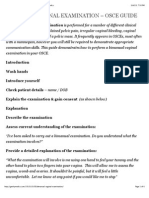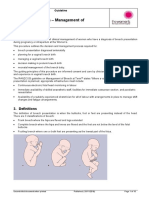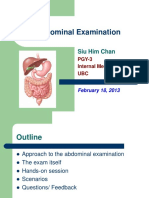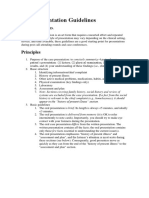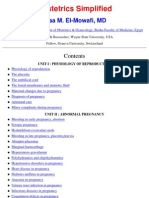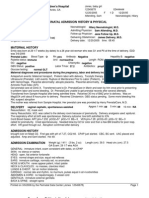OSCE OB - PDF Version 1
OSCE OB - PDF Version 1
Uploaded by
FNaF is love FNaF is lifeCopyright:
Available Formats
OSCE OB - PDF Version 1
OSCE OB - PDF Version 1
Uploaded by
FNaF is love FNaF is lifeOriginal Description:
Original Title
Copyright
Available Formats
Share this document
Did you find this document useful?
Is this content inappropriate?
Copyright:
Available Formats
OSCE OB - PDF Version 1
OSCE OB - PDF Version 1
Uploaded by
FNaF is love FNaF is lifeCopyright:
Available Formats
OSCE: OB-GYNE
CTG READING
Cardiotocography (CTG) is used during pregnancy to monitor both the foetal heart and the contractions of the uterus. It
is usually only used in the 3rd trimester. It’s purpose is to monitor foetal well-being and allow early detection of foetal
distress. An abnormal CTG indicates the need for more invasive investigations and may lead to the need for emergency
caesarian section.
How to read a CTG?
To interpret a CTG you need a structured method of assessing its various characteristics.
The most popular structure can be remembered using the acronym DR C BRAVADO
DR – Define Risk
C – Contractions
BRa – Baseline Rate
V – Variability
A – Accelerations
D – Decelerations
O – Overall impression
Define risk
You first need to assess if this pregnancy is high or low risk.
This is important as it gives more context to the CTG reading – e.g. If the pregnancy is high risk, your threshold for
intervening may be lowered.
Reasons a pregnancy may be considered high risk are shown below:
Maternal medical illness
Gestational diabetes
Hypertension
Asthma
Obstetric complications
Multiple gestation
Postdate gestation
Previous cesarean section
Intrauterine growth restriction
Premature rupture of membranes
Congenital malformations
Oxytocin induction/augmentation of labour
Pre-eclampsia
Other risk factors
Absence of prenatal care
Smoking
Drug abuse
Contractions
- Record the number of contractions present in a 10 minute period – e.g. 3 in 10
- Each big square is equal to 1 minute, so look at how many contractions occurred within 10 squares.
- Individual contractions are seen as peaks on the part of the CTG monitoring uterine activity.
You should assess contractions for the following:
o Duration – how long do the contractions last?
o Intensity – how strong are the contractions? (assessed using palpation)
© FAAS 3A, 2018
.²
In this example there are 2-3 contractions in a 10 minute period – e.g. 3 in 10
Baseline rate of the fetal heart
The baseline rate is the average heart rate of the fetus within a 10 minute window.
Look at the CTG and assess what the average heart rate has been over the last 10 minutes.
Ignore any accelerations or decelerations.
A normal fetal heart rate is between 110-150 bpm.
Fetal tachycardia
- Fetal tachycardia is defined as a baseline heart rate greater than 160 bpm.
It can be caused by:
o Fetal hypoxia
o Chorioamnionitis – if maternal fever also present
o Hyperthyroidism
o Fetal or maternal anaemia
o Fetal tachyarrhythmia
© FAAS 3A, 2018
Fetal bradycardia
- Fetal bradycardia is defined as a baseline heart rate less than 120 bpm.
Mild bradycardia of between 100-120 bpm is common in the following situations:
o Postdate gestation
o Occiput posterior or transverse presentations
Severe prolonged bradycardia (< 80 bpm for > 3 minutes) indicates severe hypoxia.
Causes of prolonged severe bradycardia are:
o Prolonged cord compression
o Cord prolapse
o Epidural & spinal anaesthesia
o Maternal seizures
o Rapid foetal descent
If the cause cannot be identified and corrected, immediate delivery is recommended.
Variability
- Baseline variability refers to the variation of foetal heart rate from one beat to the next.
- Variability occurs as a result of the interaction between the nervous system, chemoreceptors, baroreceptors and
cardiac responsiveness.
- Therefore it is a good indicator of how healthy the foetus is at that particular moment in time.
- This is because a healthy foetus will constantly be adapting its heart rate to respond to changes in its
environment.
- Normal variability is between 10-25 bpm³
- To calculate variability you look at how much the peaks and troughs of the heart rate deviate from the baseline
rate (in bpm)
Variability can be categorised as:
o Reassuring – ≥ 5 bpm
o Non-reassuring – < 5bpm for between 40-90 minutes
o Abnormal – < 5bpm for >90 minutes
..
© FAAS 3A, 2018
Reduced variability can be caused by:
o Fetal sleeping – this should last no longer than 40 minutes – most common cause
o Fetal acidosis (due to hypoxia) – more likely if late decelerations are also present
o Fetal tachycardia
o Drugs – opiates / benzodiazepines / methyldopa / magnesium sulphate
o Prematurity – variability is reduced at earlier gestation (<28 weeks)
o Congenital heart abnormalities
Accelerations
- Accelerations are an abrupt increase in baseline heart rate of >15 bpm for >15 seconds.
- The presence of accelerations is reassuring.
- Antenatally there should be at least 2 accelerations every 15 minutes¹.
- Accelerations occurring alongside uterine contractions is a sign of a healthy foetus.
- However the absence of accelerations with an otherwise normal CTG is of uncertain significance.
Decelerations
- an abrupt decrease in baseline heart rate of >15 bpm for >15 seconds.
There are a number of different types of decelerations, each with varying significance:
Early deceleration
- Early decelerations start when uterine contraction begins and recover when uterine contraction stops.
- This is due to increased foetal intracranial pressure causing increased vagal tone.
- It therefore quickly resolves once the uterine contraction ends and intracranial pressure reduces.
- This type of deceleration is therefore considered to be physiological and not pathological.
Variable deceleration
- Variable decelerations are observed as a rapid fall in baseline rate with a variable recovery phase.
- They are variable in their duration and may not have any relationship to uterine contractions.
- They are most often seen during labour and in patients’ with reduced amniotic fluid volume.
© FAAS 3A, 2018
Variable decelerations are usually caused by umbilical cord compression:
o The umbilical vein is often occluded first causing an acceleration in response.
o Then the umbilical artery is occluded causing a subsequent rapid deceleration.
o When pressure on the cord is reduced another acceleration occurs and then the baseline rate returns.
o Accelerations before and after a variable deceleration are known as the “shoulders of deceleration“.
o Their presence indicates the foetus is not yet hypoxic and is adapting to the reduced blood flow.
Variable decelerations can sometimes resolve if the mother changes position.
The presence of persistent variable decelerations indicates the need for close monitoring.
Variable decelerations without the shoulders is more worrying as it suggests the fetus is hypoxic.
Late deceleration
- Late decelerations begin at the peak of uterine contraction and recover after the contraction ends.
- This type of deceleration indicates there is insufficient blood flow through the uterus and placenta.
- As a result blood flow to the fetus is significantly reduced causing fetal hypoxia and acidosis.
.
Reduced utero-placental blood flow can be caused by:
o Maternal hypotension
o Pre-eclampsia
o Uterine hyperstimulation
.
The presence of late decelerations is taken seriously and fetal blood sampling for pH is indicated.
If foetal blood pH is acidotic it indicates significant fetal hypoxia and the need for emergency C-section.
Prolonged deceleration
- A deceleration that last more than 2 minutes.
- If it lasts between 2-3 minutes it is classed as non-reassuring.
- If it lasts longer than 3 minutes it is immediately classed as abnormal.
Action must be taken quickly – e.g. foetal blood sampling / emergency C-section
© FAAS 3A, 2018
Sinusoidal pattern
- This type of pattern is rare, however if present it is very serious.
- It is associated with high rates of foetal morbidity & mortality.
- It is described as:
o A smooth, regular, wave-like pattern
o Frequency of around 2-5 cycles a minute
o Stable baseline rate around 120-160 bpm
o No beat to beat variability
A sinusoidal pattern indicates:
o Severe foetal hypoxia
o Severe foetal anaemia
o Foetal/maternal haemorrhage
.
Immediate C-section is indicated for this kind of pattern.
Outcome is usually poor.
Overall impression
Once you have assessed all aspects of the CTG you need to give your overall impression.
The overall impression can be described as either:
Reassuring
Suspicious
Pathological
The overall impression is determined by how many of the CTG features were either reassuring, non-reassuring or
abnormal. The NICE guideline below demonstrates how to decide which category a CTG falls into.
© FAAS 3A, 2018
© FAAS 3A, 2018
LABOR CURVE
Labor: uterine contractions that bring about demonstrates effacement and dilatation of the cervix; intact membranes with
cervical dilatation of ≤ 3-4 cm
First stage of labor
Preparation division
o Cervix dilates little
o Changes in connective tissue
components
o Can be arrested with sedation and
conduction analgesia
o Latent and acceleration
Dilation division
o Dilation proceeds at its most rapid rate
o Unaffected by sedation
o Phase of maximum slope
Pelvic division
o Deceleration phase of cervical dilatation
o Cardinal fetal movements of the cephalic
presentation
o Deceleration and second stage
Two phases of cervical dilatation:
Latent phase – preparatory division; <4 cm cervical dilatation
Active phase (acceleration, phase of maximum slope, deceleration phase) – dilatation division; >4cm cervical
dilatation
Prolonged latent stage:
Nullipara: > 20 hours
Multipara: > 14 hours
Active labor
- Cervical dilatation of 3-5 cm or more in the presence of uterine contractions
- Descent begins in the later stage of active dilation commencing at 7-8cm in multiparous and becomes most rapid
after 8 cm
© FAAS 3A, 2018
Protraction
- Slow rate of cervical dilatation or descent
o Nulli: < 1.2 cm dilatation / hour or 1
cm/hr
o Multi: < 1.5 cm dilatation/hour or 2
cm/hr
Arrest
- Complete cessation of dilatation or descent
- 4-8cm for more than 2 hours
o Arrest of dilation: 2 hours without
cervical change
o Arrest of descent: 1 hour without fetal
descent
Second stage of labor
- Begins with complete cervical dilation and
ends with fetal delivery
o Nulli: 50 minutes
o Multi: 20 minutes
COMPUTATION: AOG, EDC, EFW
EDC = Date of LMP - ( 3, +7, +1)
i.e.: 11-21-2016
-3+7+ 1
8-27-2017
AOG = height of fundus in cm – age of gestation in weeks (20-30 weeks only)
EFW = (gms) 155 (HF – n)
EFW = (lbs) 0.3414 (FH – n)
In which n = 13 if station is -1, -2, -3, -4, -5
n = 12 if station is 0
n = 11 is station is +1, +2, +3, +4, +5
© FAAS 3A, 2018
LEOPOLD’S MANEUVER
1. Introduce yourself to the patient and clarify the patient’s identity
2. Explain the procedure to the patient and/ or significant others step by step and gain informed consent to continue.
Ask if the patient needs a chaperone during the procedure
3. Ask if they have any questions or points to clarify with regards to the procedure. It is worth explaining that the
procedure
4. Maneuver 1
Identify what part occupies the fundus
With the examiner at the side facing the mother’s head, place fingertips over the fundal area of the uterus
If palpated an irregular, broad firm, non-ballotable mass at the fundus, this is probably the breech part,
and therefore cephalic in presentation
5. Maneuver 2
Determine what fetal pole occupies the left and right side of the mother’s abdomen
With the examiner at the side facing the mother’s head, apply pressure on one side of the abdomen with
one hand, while the other hand palpates the other side
If palpated small angular nodulations, these are fetal small parts. If palpated a hard resistant plane, it is
the fetal back
6. Maneuver 3
Determine what fetal pole occupies the lower part of the abdomen, and whether the presenting part is
floating or engaged
With the examiner at the left side facing the mother’s head, thumb and fingers of one hand are applied on
both side of the lower abdomen just above the symphysis pubis
To determine the degree of descent, the examiner will attempt to move the presenting part to determine
the degree of descent
o If movable, the presenting part is floating
o If fixed, the presenting part is already engaged
7. Maneuver 4
To determine the fetal descent
With the examiner at the left side facing the lower extremities of the mother, apply one hand on each side
of the abdomen and direct it in standing motion towards the pelvic inlet. Tips of the 1 st 3 fingers of each
hand exert deep pressure in the direction of the axis of the pelvic inlet
The vertex – cephalic position is on the same side as the small parts
If the head is engaged, the hands are divergent
If the head is unengaged, the hands are convergent
© FAAS 3A, 2018
TOUCH PICTURE
Anterior fontanel: diamond
Posterior fontanel: triangle
LM1: fetal part occupies the fundus
- Broad, firm, nodular – breech
- Round, ballotable – head
LM2: Fetal back, fetal small parts
LM3: what presents at the pelvis
- Floating: not engaged
- Fixed: engaged (do not do LM4)
LM4: cephalic prominence
OBSTETRICAL HEMORRHAGE
Obstetrical hemorrhage: first trimester, third trimester and postpartum hemorrhage
Anterpartum hemorrhage: vaginal bleeding from 22 weeks of gestation up to delivery
Postpartum hemorrhage: loss of 500 mL of blood or more after completion of the third stage of labor
1st trimester:
Ectopic pregnancy
Abortion
H. mole
© FAAS 3A, 2018
rd
3 trimester hemorrhage
Placenta previa
- Placenta is implanted over or very near the internal os
Total: internal os is covered completely
Partial: internal os is partially covered by the placenta
Marginal: edge of the placenta is at the margin of the internal os
Low-lying: placenta is implanted in the lower uterine segment such that the placental edge does
not reach the internal os, but is in close proximity to it
Vasa previa: fetal vessels course through the membranes and present at the cervical os
Management:
Preterm, placenta previa, no bleeding – tocolytic agents, steroids
Full term, previa, bleeding, in labor – prepare double set-up, do internal exam, CS
Full term, previa, not bleeding – elective CS
Full term, minimal bleeding – ultrasound
Preterm, bleeding profusely – CS
Abruption placenta
- Placental separation from its implantation site before delivery
- Premature separation of the normally implanted placenta
- Causes: hypertension, abuse, trauma, etc.
If >50% of placenta detached do cesarean section
Postpartum hemorrhage
- After delivery
o Trauma (i.e. laceration, uterine rupture) – repair
o Tone (atony) – uterotonics
o Tissue (products of conception left inside) – remove tissue, curettage
o Thrombin (coagulopathy) – give blood components
HYPERTENSIVE DISORDERS
Chronic hypertension – hypertension < 20 weeks
Gestational hypertension – BP >140/90 mmHg, no proteinuria
Preeclampsia - > 20 weeks, high BP, with proteinuria
o Preeclampsia with severe features
End organ damage
Very high proteinuria
Elevated liver enzymes
Intrauterine growth restriction
Gestational hypertension
- BP ≥140/90 mmhg for the 1sr time during pregnancy after 20 weeks
- NO PROTEINURIA
- BP returns to normal within 12 weeks after delivery
Preeclampsia
- BP≥= 140/90
- PROTEINURIA
• 300MG/24 hour urine sample
• (+) 1 dipstick
• Urine protein/creatinine ration 0.3 mg/dl
Eclampsia
- Defined as the presence of new-onset grand mall seizures in a woman with preeclampsia
- It can occur before, during, or after labor
- Seizures that cannot be attributed to other causes in a woman with preeclampsia
Chronic hypertension
- BP ≥140/90 mmHg before pregnancy or diagnosed before 20 weeks’ gestation;
- Or hypertension first diagnosed after 20 weeks’ gestation and persistent after 12 weeks’ postpartum
© FAAS 3A, 2018
Superimposed preeclmapsia (on chronic hypertension)
• Women with hypertension only in early gestation who develop proteinuria after 20 weeks of gestation
• Women with hypertension and proteinuria before 20 weeks of gestation who:
1. sudden exacerbation of hypertension
2. platelet count <100,000
3. elevation of liver enzymes
4. pulmonary edema
5. RUQ pain/severe headaches
6. Substantial increase in proteinuria
Seizure Prophylaxis
Magnesium sulfate- an anti-convulsant
Loading dose: 4 grams in 20% solution slow IVTT; 5 grams in 50% solution deep IM each buttocks
4 hours after start magnesium sulfate maintenance dose: 5 grams in 50% solution deep IM to alternate buttocks every 4
hours for 6 doses after checking the parameters:
DTR ++
RR >16 cpm
UO >30 cc/hr
Antihypertensive Drugs
- Anti-hypertensive drugs are initiated only if BP is more than or equal to 160/110mmHg- prevent intracranial
hemorrhage
Hydralazine 5mg IV every, then 5mg every 30 minutes for a max 20mg
Nifedipine 10-20 mg OD, then 10-20 mg every 6 hours max of 20mg
Methyldopa max of 3 grams per day
Labetalol not readily available locally
Antenatal Corticosteroids
• Dexamethasone 6mg deep IM every 12 hours for 48 hours
• Betamethasone 12mg deep, IM every 24 hours x 2 doses
VAGINITIS/ CERVICITIS/ POST-COITAL BLEEDING
© FAAS 3A, 2018
PAPSMEAR, SPECULUM EXAM
1. Introduce yourself to the patient and clarify the patient’s identity
2. Explain the procedure to the patient and/ or significant others step by step and gain informed consent to continue
3. Ask if they have any questions or points to clarify with regards to the procedure. It is worth explaining that the
procedure may cause some discomfort but that it will be shortly lived
4. Ensure that all of the materials and equipment ready:
a. Sterile vaginal speculum
b. Glass slides
c. Cytobrush/ cytobroom/ Ayre’s spatula
d. Fixative spray or 95% ethanol fixative in a bottle
e. Sterile gloves
f. Warm bottle of water
g. Goose neck lamp or any light source available
h. Fenestrated drape/ eye sheet
i. Water-soluble lubrication gel (KY jelly)
5. Position the patient on a supine dorsal lithotomy position with knees apart. If available, Goose neck lamp
positioned illuminating the perineum
6. Perform proper handwashing and then dry both hands, then wear sterile gloves
7. Examiner positioned facing the patient between the legs, in a sitting position
8. Apply the sterile fenestrated drape over the perineum
9. Hold the speculum with the dominant hand, then check the temperature of the speculum
10. Separate the labia with the non-dominant hand. Use warm water as lubricant
11. Introduce the speculum into the vagina with blades oblique, closed and pressed against the perineum
12. Carry the speculum along the posterior vaginal wall until it is fully inserted into the canal
13. Rotate blades into horizontal position, then open slowly exposing the cervix
14. With cervix exposed in between the blades, insert cytobrush/ cytobroom, spatula and roll out firmly against the
canal in clock – wise fashion
15. Rotate the cytobrush against the slide in a clock – wise manner. If using a cytobroom or a spatula, make a smear
on the slide in a sliding motion. Make sure to make a smear from both sides of the brush/spatula
16. Fix the slide immediately with a spray fixative held 9-12 inches from the slide or by placing the slide in a 95%
ethanol fixative. Discard the cytobrush properly in the trash bin
BIMANUAL PELVIC EXAM
17. Position the patient on a supine dorsal lithotomy position with knees apart with examiner positioned facing the
patient between the legs, in a standing position
18. Place non dominant hand over the lower abdominal wall just above the symphysis pubis
19. Apply adequate amount of water-soluble lubricant gel on the index and middle fingers of the gloved dominant
hand. Separate the labia using the non-dominant hand then introduce the index and middle fingers of the hand
into the vagina
20. Test the strength of the perineum by pressing downward on the perineum. Ask the patient to bear down
21. Palpate the cervix. Then sweep fingers in the vagina posterior to the cervix
22. Apply suprapubic pressure with the non-dominant hand and asses the uterus
23. Position the fingers in the vagina n the right lateral fornix. Place the non-dominant hand just medial to the anterior
superior iliac spine on the right
24. Bring both hands close as together as possible to outline the right adnexa. Try to palpate for the right ovary and
right fallopian tube
25. Perform the same for the left adnexa
26. Proceed to rectovaginal exam. Apply lubricant on the middle finger of the dominant hand then insert it into the
rectum very gently while the index finger is reinserted into the vagina. Palpate the rectovaginal septum between
the 2 fingers
27. Remove the fingers gently. Record findings
AMENORRHEA/ AUB/ PELVIC PAIN
Amenorrhea
- Absence of menses during the reproductive years (for atleast 6 months)
• Primary: absence of spontaneous menses older than 16.5 years of age
• Secondary: absence of menses for a variable period of time (3-13 months, usually 6 months or longer) in
an individual who has previously had spontaneous menstrual periods
© FAAS 3A, 2018
Abnormal uterine bleeding (AUB/ DUB)
Menorrhagia – prolonged excessive (> 7 ays, >80 mL) uterine bleeding occurring at regular intervals
Metrorrhagia – uterine bleeding occurring at irregular but frequent intervals, variable amount
Menometrorrhagia – prolonged uterine bleeding occurring at irregular intervals
Intermenstrual bleeding – bleeding of variable amounts, occurring between regular menstrual periods
Polymenorhea – uterine bleeding occurring at regular intervals of less than 21 days
Infrequent uterine bleeding, intervals between episodes vary from 35 days to 6 months
Amenorrhea – no menses for atleast 6 months
Anatomical causes: Non-anatomical causes:
Polyp Coagulopathy
Adenomyosis Oculation disorders
Leiomyoma Endometrial pathology
Malignancy Iatrogenic
Non-otherwise specified
FAMILY PLANNING
Natural
Calendar method
Standard days method
Basal body temperature
Cervical Mucous
Artificial
OCP
Barrier
Spermicide
IUD
Ligation
Vasectomy
© FAAS 3A, 2018
You might also like
- Premature Rupture of MembranesDocument5 pagesPremature Rupture of MembranesAnonymous pYR4s37H6No ratings yet
- Osce-Stations - Blogspot.co - Id-Cervical Smear Amp ExamDocument2 pagesOsce-Stations - Blogspot.co - Id-Cervical Smear Amp ExamPatrick BayuNo ratings yet
- ObsGyn OSCE Notes PDFDocument52 pagesObsGyn OSCE Notes PDFNorman Ahmad RiyandiNo ratings yet
- Maternity - Perineal TearsDocument4 pagesMaternity - Perineal TearsJunarto Butar ButarNo ratings yet
- Dysfunctional LabourDocument128 pagesDysfunctional LabourDebjyoti KarmakarNo ratings yet
- DBL Group CSRDocument4 pagesDBL Group CSRMizan Patwary100% (1)
- Case 10: Placenta Previa: ST ND RDDocument6 pagesCase 10: Placenta Previa: ST ND RDMengda ZhangNo ratings yet
- Summary of Obstetrics CasesDocument7 pagesSummary of Obstetrics CasesMahir AminNo ratings yet
- Obstetrics and GynecologyDocument36 pagesObstetrics and GynecologyLeiNo ratings yet
- 2015 Clinical Practice Guidelines On Obstetric and Gynecologic Infectious DiseasesDocument59 pages2015 Clinical Practice Guidelines On Obstetric and Gynecologic Infectious DiseasesSaint Pauls ObgynNo ratings yet
- Obstetric ExamDocument194 pagesObstetric ExamHimmz100% (1)
- Idea of OSCE in Obstetric.4012829.Powerpoint 1Document19 pagesIdea of OSCE in Obstetric.4012829.Powerpoint 1Aitzaz AhmedNo ratings yet
- Bimanual Vaginal Examination - OSCE Guide - Geeky MedicsDocument6 pagesBimanual Vaginal Examination - OSCE Guide - Geeky MedicsJahangir AlamNo ratings yet
- Breech - Management Of: 1. PurposeDocument15 pagesBreech - Management Of: 1. PurposeMuathNo ratings yet
- Ped OsceDocument4 pagesPed OsceAJ JeyakumarNo ratings yet
- 02 Gestational Trophoblastic DiseaseDocument8 pages02 Gestational Trophoblastic Diseasemisakichan FrandoNo ratings yet
- Obs&Gyn MDC Q and ADocument36 pagesObs&Gyn MDC Q and ARufai Abdul WahabNo ratings yet
- Im InjectionDocument4 pagesIm InjectionKaur KaurNo ratings yet
- Obstetric ExaminationDocument4 pagesObstetric ExaminationSusan GeorgeNo ratings yet
- Done By: Abdul Hakeem Hady. Gynecology SlidesDocument16 pagesDone By: Abdul Hakeem Hady. Gynecology Slidesعمر احمد شاكرNo ratings yet
- Osce PG 1Document18 pagesOsce PG 1Mobin Ur Rehman Khan100% (1)
- OSCE On 14/3/2008: Describe Gynaecoid PelvisDocument82 pagesOSCE On 14/3/2008: Describe Gynaecoid PelvisKahing LiNo ratings yet
- Cord ProlapseDocument3 pagesCord ProlapseNise Mon KuriakoseNo ratings yet
- Ospe Bank PDFDocument318 pagesOspe Bank PDFMed StudentNo ratings yet
- OSCE Gynae HXDocument3 pagesOSCE Gynae HXmpage3100% (1)
- Abnormal OBDocument34 pagesAbnormal OBLawrence NemirNo ratings yet
- WP GynaeExams4Document37 pagesWP GynaeExams4Ahsan JamNo ratings yet
- Breast DiseasesDocument28 pagesBreast DiseasesLyk TiglaoNo ratings yet
- DystociaDocument6 pagesDystociasarguss14100% (2)
- Vaginal Swabs OSCE Guide PDFDocument8 pagesVaginal Swabs OSCE Guide PDFParsaant SinghNo ratings yet
- OB-Reviewer With AlgorithmDocument29 pagesOB-Reviewer With Algorithmriczen mae vilaNo ratings yet
- اسئلة الهيئة السعودية للاطباء - dr - mahmoudDocument413 pagesاسئلة الهيئة السعودية للاطباء - dr - mahmoudHasan DahamshehNo ratings yet
- Nursing Care of Family During Labor and BirthhhDocument6 pagesNursing Care of Family During Labor and BirthhhAudreySalvadorNo ratings yet
- Taking Obstetrical HistoryDocument20 pagesTaking Obstetrical Historymawada abdallaNo ratings yet
- Abdominal Examination: Siu Him ChanDocument18 pagesAbdominal Examination: Siu Him ChansuaqaziNo ratings yet
- Obs and Gynae OSPEDocument79 pagesObs and Gynae OSPEKitty GraceNo ratings yet
- Clinicopathological Conference OB-GYN DeepakDocument59 pagesClinicopathological Conference OB-GYN DeepakDeepak Ghimire100% (1)
- OBGYN Objective - Module Study GuideDocument79 pagesOBGYN Objective - Module Study GuideHema LaughsalotNo ratings yet
- Fluid & ElectrolyteDocument68 pagesFluid & ElectrolytePranay MallNo ratings yet
- Antepartum & Postpartum Hemorrhage (APH &PPH) : Basim Abu-RafeaDocument81 pagesAntepartum & Postpartum Hemorrhage (APH &PPH) : Basim Abu-RafeaSheilla ElfiraNo ratings yet
- Obstetrics, Gynaecology and NeonatologyDocument102 pagesObstetrics, Gynaecology and Neonatologyjames.a.blairNo ratings yet
- OSCE Gynae-OSCE-MMSSDocument24 pagesOSCE Gynae-OSCE-MMSSMohammad Saifullah100% (1)
- OBGYNE Must-KnowsDocument10 pagesOBGYNE Must-KnowsPigwet KwisNo ratings yet
- Oral Presentation GuidelinesDocument6 pagesOral Presentation GuidelinesDIANA MARIA TORO GOMEZNo ratings yet
- Obstetrical Emergency & ManagementDocument38 pagesObstetrical Emergency & ManagementDrPreeti Thakur ChouhanNo ratings yet
- Sexually Transmitted DiseasesDocument5 pagesSexually Transmitted Diseasesreghpineda28No ratings yet
- Essays For Obs N GYn 1Document8 pagesEssays For Obs N GYn 1whoosh2008No ratings yet
- Ob-Gy HX & P-EDocument83 pagesOb-Gy HX & P-Emaezu100% (2)
- OSCE Student Exam in Obstetrics &gynecology: DR: Manal Behery Faculty of Medicine, Zagazig University 2014Document64 pagesOSCE Student Exam in Obstetrics &gynecology: DR: Manal Behery Faculty of Medicine, Zagazig University 2014Karam SaadNo ratings yet
- Fetal MonitoringDocument6 pagesFetal MonitoringRraouzmaaliNo ratings yet
- NotesDocument16 pagesNotesvk4bftgg2kNo ratings yet
- Ogexamination 110401040414 Phpapp02 PDFDocument26 pagesOgexamination 110401040414 Phpapp02 PDFDika RizkiardiNo ratings yet
- Obstetics Simplified El-MowafiDocument515 pagesObstetics Simplified El-Mowafiapi-370504650% (2)
- Neonatal History and Physical ExamDocument2 pagesNeonatal History and Physical ExamMuhammad Farhan Khaliq100% (1)
- Gynecology Notes Legal Issues and EthicsDocument19 pagesGynecology Notes Legal Issues and EthicsUsm LeeNo ratings yet
- Singer and Monaghan's Cervical and Lower Genital Tract Precancer: Diagnosis and TreatmentFrom EverandSinger and Monaghan's Cervical and Lower Genital Tract Precancer: Diagnosis and TreatmentRating: 5 out of 5 stars5/5 (1)
- INPATIENT OBSTETRIC NURSING: Passbooks Study GuideFrom EverandINPATIENT OBSTETRIC NURSING: Passbooks Study GuideNo ratings yet
- OHNS--Otolaryngology; Head and Neck surgery: pocket field guideFrom EverandOHNS--Otolaryngology; Head and Neck surgery: pocket field guideNo ratings yet
- Cyanosis, A Simple Guide To The Condition, Diagnosis, Treatment And Related ConditionsFrom EverandCyanosis, A Simple Guide To The Condition, Diagnosis, Treatment And Related ConditionsRating: 5 out of 5 stars5/5 (1)
- (Olfu) Pediatrics Case Study: Post Streptococcal Glomerulo Nephritis (PSGN)Document20 pages(Olfu) Pediatrics Case Study: Post Streptococcal Glomerulo Nephritis (PSGN)MikaCasimiroBalunanNo ratings yet
- Hypertensive UrgencyDocument15 pagesHypertensive UrgencyKier_John_Kora_907667% (3)
- Functional Assessment ScaleDocument5 pagesFunctional Assessment ScaleJose Paul RaderNo ratings yet
- Health Service Delivery Analysis, Hospital & Health Workforce MasterplanDocument13 pagesHealth Service Delivery Analysis, Hospital & Health Workforce MasterplanADB Health Sector GroupNo ratings yet
- Introduction (Hyperbilirubinemia)Document5 pagesIntroduction (Hyperbilirubinemia)bluewipesNo ratings yet
- Electronic Medical Records: Advantages and DisadvantagesDocument4 pagesElectronic Medical Records: Advantages and DisadvantagesShelly BadialaNo ratings yet
- A Study On Clinical Librarianship in Medical Libraries in The Philippines Towards The Integration of A Clinical Medical Librarian ProgramDocument9 pagesA Study On Clinical Librarianship in Medical Libraries in The Philippines Towards The Integration of A Clinical Medical Librarian ProgramLiz ZieNo ratings yet
- Study GuideDocument17 pagesStudy GuideKellie PacanowskiNo ratings yet
- DBMS Case Studies CSE IVSemDocument23 pagesDBMS Case Studies CSE IVSemsatishgwNo ratings yet
- Diarrhea CareplanDocument6 pagesDiarrhea CareplanAmira Fatmah QuilapioNo ratings yet
- Further, That The Judicial Proceedings Be Held in Executive SessionDocument10 pagesFurther, That The Judicial Proceedings Be Held in Executive SessionlamadridrafaelNo ratings yet
- Anemia PosterDocument8 pagesAnemia PosterUshadevi KaranamNo ratings yet
- Anemia NCPDocument10 pagesAnemia NCPCharmz_asherah100% (10)
- Pattern of Hospital Admission and Outcome in Parkinson's Disease: A Study From Punjab, IndiaDocument7 pagesPattern of Hospital Admission and Outcome in Parkinson's Disease: A Study From Punjab, IndiaYan Hein TanawaniNo ratings yet
- Chapter 3 Practice (Leadership) Theories and Principles of Nursing Lead-Ership and ManagementDocument2 pagesChapter 3 Practice (Leadership) Theories and Principles of Nursing Lead-Ership and ManagementVincent Paul PagulayanNo ratings yet
- Stem Cell Research Essay TextDocument9 pagesStem Cell Research Essay Textapi-302123415No ratings yet
- Nutrition AssessmentDocument22 pagesNutrition AssessmentMuhammad Rizal Adriyansyah100% (2)
- (Brand Name) & Date Ordered General Class and Family Specific IndicationDocument2 pages(Brand Name) & Date Ordered General Class and Family Specific IndicationNicole Grace VillegasNo ratings yet
- SickLeaveCertificate With and Without Diagnosis 20231122 133615Document2 pagesSickLeaveCertificate With and Without Diagnosis 20231122 133615Elias TemblorNo ratings yet
- 8 Advanced Diagnostics and CytologyDocument43 pages8 Advanced Diagnostics and CytologyGaurav KapoorNo ratings yet
- Examination of The AbdomenDocument19 pagesExamination of The AbdomenAllen AykayNo ratings yet
- Hematology 2 Lecture Notes Platelet Qualitative DisordersDocument4 pagesHematology 2 Lecture Notes Platelet Qualitative DisorderscccomayogNo ratings yet
- RSDocument682 pagesRSDeni ArdiansyahNo ratings yet
- Emergency Crash Cart Checklist (2010) Yes NoDocument2 pagesEmergency Crash Cart Checklist (2010) Yes Nosabbo mors100% (1)
- Best of The Triangle 2015Document40 pagesBest of The Triangle 2015The DispatchNo ratings yet
- ECG Definition: - PurposeDocument2 pagesECG Definition: - PurposeJustine Karl Pablico100% (1)
- NURS FPX 6030 Assessment 6 Final Project SubmissionDocument11 pagesNURS FPX 6030 Assessment 6 Final Project Submissionzadem5266No ratings yet
- ASRA Guidelines Regional Anaesthesia in Anticoagulated PatientDocument10 pagesASRA Guidelines Regional Anaesthesia in Anticoagulated PatientRizg AlamriNo ratings yet
- Ethics Case AnalysisDocument2 pagesEthics Case AnalysisSALAZAR JAN LOUISNo ratings yet












